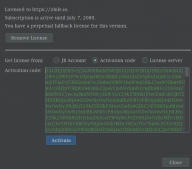前言
在许多的情况下,很多要匹配内容是一起出现,或者一起不出现的。比如《》,< >,这样的括号,不存在使用半个的情况。因此,在正则表达式里也有一致性的判断,要么两个尖括号一起出现,要么一个也不要出现。怎么样来实现这种判断呢?针对这种情况得引入新的正则表达式的语法:(?=pattern),这个语法它会向前搜索或者向后搜索相关内容,如果不会出现就不能匹配。不过,这个匹配不会消耗任何输入的字符,它只是查看一下。
例子如下:
|
1
|
|
2
3
4
5
6
7
8
9
10
11
12
13
14
15
16
17
18
19
20
21
22
23
24
25
26
27
28
29
30
31
32
33
34
35
36
37
38
39
40
41
42
43
44
45
46
47
48
49
50
51
52
53
|
#python 3.6 #蔡军生 #http://blog.csdn.net/caimouse/article/details/51749579 # import re address = re.compile( ''''' # A name is made up of letters, and may include "." # for title abbreviations and middle initials. ((?P<name> ([\w.,]+\s+)*[\w.,]+ ) \s+ ) # name is no longer optional # LOOKAHEAD # Email addresses are wrapped in angle brackets, but only # if both are present or neither is. (?= (<.*>$) # remainder wrapped in angle brackets | ([^<].*[^>]$) # remainder *not* wrapped in angle brackets ) <? # optional opening angle bracket # The address itself: username@domain.tld (?P<email> [\w\d.+-]+ # username @ ([\w\d.]+\.)+ # domain name prefix (com|org|edu) # limit the allowed top-level domains ) >? # optional closing angle bracket ''', re.VERBOSE) candidates = [ u'First Last <first.last@example.com>', u'No Brackets first.last@example.com', u'Open Bracket <first.last@example.com', u'Close Bracket first.last@example.com>', ] for candidate in candidates: print('Candidate:', candidate) match = address.search(candidate) if match: print(' Name :', match.groupdict()['name']) print(' Email:', match.groupdict()['email']) else: print(' No match') |
结果输出如下:
|
1
|
|
2
3
4
5
6
7
8
9
10
|
Candidate: First Last <first.last@example.com> Name : First Last Email: first.last@example.comCandidate: No Brackets first.last@example.com Name : No Brackets Email: first.last@example.comCandidate: Open Bracket <first.last@example.com No matchCandidate: Close Bracket first.last@example.com> No match |
python里使用正则表达式的前向搜索否定模式
上面学习前向搜索或后向搜索模式(?=pattern),这个模式里看到有等于号=,它是表示一定相等,其实前向搜索模式里,还有不相等的判断。比如你需要识别EMAIL地址:noreply@example.com,这个EMAIL地址大多数是不需要回复的,所以我们要把这个EMAIL地址识别出来,并且丢掉它。怎么办呢?这时你就需要使用前向搜索否定模式,它的语法是这样:(?!pattern),这里的感叹号就是表示非,不需要的意思。比如遇到这样的字符串:noreply@example.com,它会判断noreply@是否相同,如果相同,就丢掉这个模式识别,不再匹配。
例子如下:
|
1
|
|
2
3
4
5
6
7
8
9
10
11
12
13
14
15
16
17
18
19
20
21
22
23
24
25
26
27
28
29
30
31
32
33
34
35
36
|
#python 3.6 #蔡军生 #http://blog.csdn.net/caimouse/article/details/51749579 # import re address = re.compile( ''''' ^ # An address: username@domain.tld # Ignore noreply addresses (?!noreply@.*$) [\w\d.+-]+ # username @ ([\w\d.]+\.)+ # domain name prefix (com|org|edu) # limit the allowed top-level domains $ ''', re.VERBOSE) candidates = [ u'first.last@example.com', u'noreply@example.com', ] for candidate in candidates: print('Candidate:', candidate) match = address.search(candidate) if match: print(' Match:', candidate[match.start():match.end()]) else: print(' No match') |
结果输出如下:
|
1
|
|
2
3
4
|
Candidate: first.last@example.com Match: first.last@example.comCandidate: noreply@example.com No match |
总结
以上就是这篇文章的全部内容了,希望本文的内容对大家的学习或者工作具有一定的参考学习价值,如果有疑问大家可以留言交流,谢谢大家对服务器之家的支持。
原文链接:http://blog.csdn.net/caimouse/article/details/78472377





